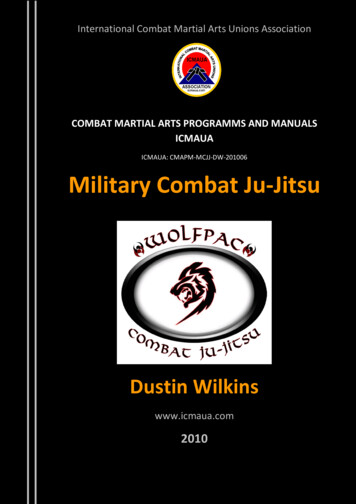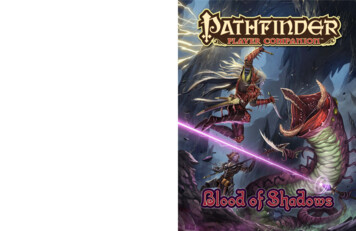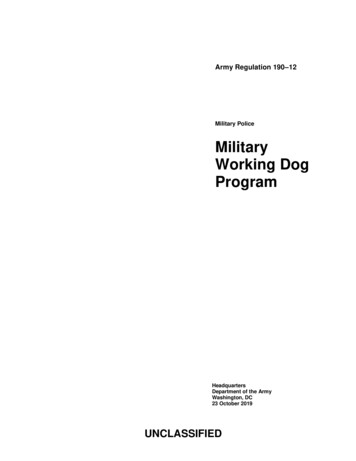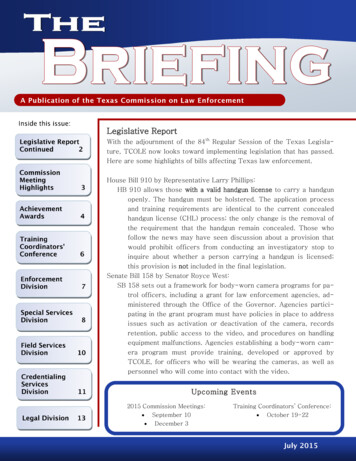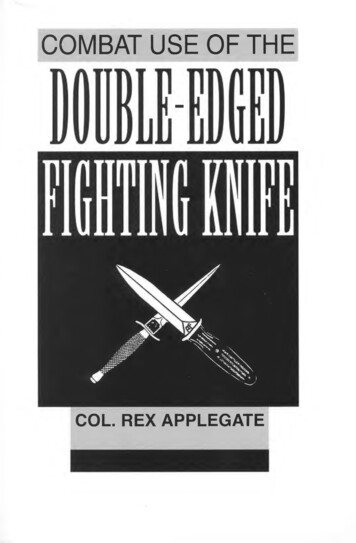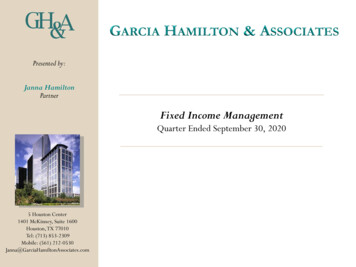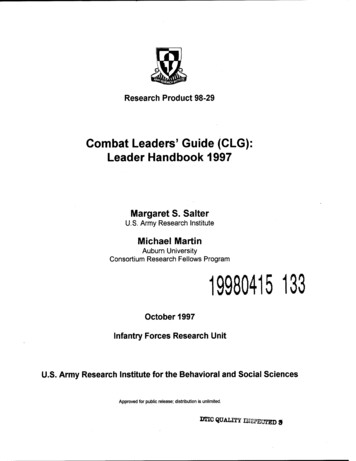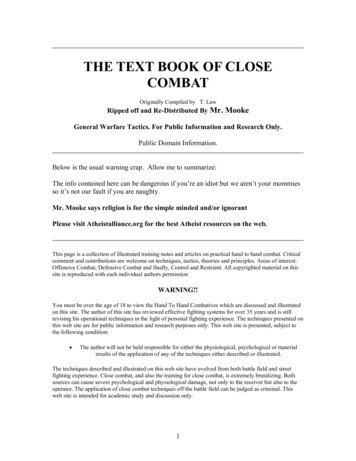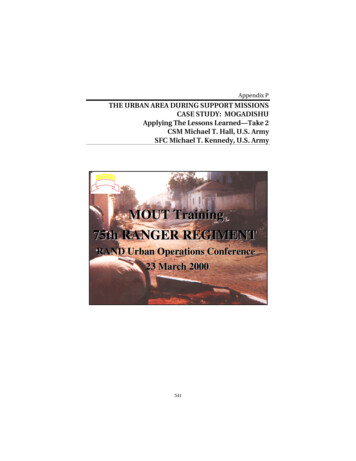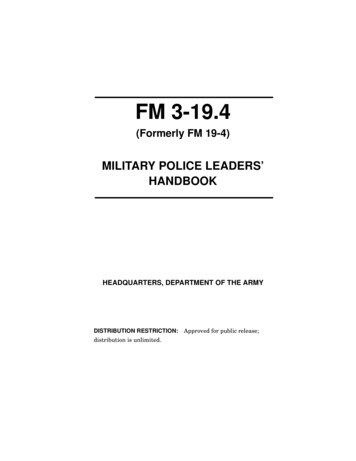
Transcription
FM 3-19.4(Formerly FM 19-4)MILITARY POLICE LEADERS’HANDBOOKHEADQUARTERS, DEPARTMENT OF THE ARMYDISTRIBUTION RESTRICTION:distribution is unlimited.Approved for public release;
FM 3-19.4 (FM 19-4)Field ManualNo. 3-19.4HeadquartersDepartment of the ArmyWashington, DC, 4 March 2002Military Police Leaders’HandbookContentsPagePREFACE . viiChapter 1MILITARY POLICE OVERVIEW . 1-1Introduction . 1-1Military Police Functional Areas . 1-2Threat. 1-6Military Police Platoon Organizationand Leadership . 1-7Force Protection (FP) Measures . 1-12Military Police Platoon Mission,Capabilities, and Limitations . 1-13Peacetime Training . 1-15Chapter 2BATTLE COMMAND. 2-1Overview . 2-1Military Decision-Making Process (MDMP). 2-2Troop-Leading Procedures . 2-11Distribution Restriction: Approved for public release; distribution isunlimited.*This publication supersedes FM 19-4, 7 May 1993.i
FM 3-19.4PageOrders and Reports .Rules of Engagement and Rules ofInteraction (ROI).Situational Awareness .Command Post Operations .Chapter 32-202-212-222-26SHOOT, MOVE, AND COMMUNICATE . 3-1Shoot . 3-1Move . 3-40Communicate. 3-58Chapter 4COMBAT OPERATIONS . 4-1Prepare for Combat . 4-1Construct Fighting and Survivability Positions . 4-24Defend a Site . 4-41Patrols. 4-46Clearing Techniques . 4-52Chapter 5MANEUVER AND MOBILITY SUPPORT . 5-1Maneuver Support . 5-1Mobility Support . 5-19Chapter 6AREA SECURITY . 6-1Reconnaissance Operations. 6-1Area Damage Control . 6-14Base Defense . 6-17Air Base Defense . 6-21Enemy Delay . 6-49Battle Handover to a Tactical Combat Force . 6-56Critical Site, Asset, and High-RiskPersonnel Security . 6-64Chapter 7INTERNMENT AND RESETTLEMENT. 7-1Overview . 7-1Enemy Prisoners of War and Civilian Internee . 7-2ii
FM 3-19.4PageUnited States Military PrisonerHandling (Field Detention Facilities) .Populace and Resource Control (PRC) .Dislocated Civilian Resettlement.Evacuation Operations .Chapter 87-217-257-277-29LAW AND ORDER . 8-1Overview . 8-1Law and Order Augmentation Detachment . 8-3Company and Platoon Level Law andOrder Operations . 8-6United States Customs Support . 8-14Multinational Law and Order Operations . 8-17Chapter 9POLICE INTELLIGENCE OPERATIONS . 9-1Overview .Police Information AssessmentProcess .Police Information.Responsibilities .9-19-29-39-7Appendix AMETRIC CONVERSION CHART. A-1Appendix BMEDIA RELATIONS . B-1Overview . B-1Media Interaction. B-1Appendix CTRAINING EXECUTION MODEL . C-1Overview . C-1Task Identification . C-1Appendix DORDERS AND REPORTS. D-1Orders . D-1Reports. D-4iii
FM 3-19.4PageAppendix EPRECOMBAT INSPECTIONS . E-1Modified Precombat Inspection Checklist . E-1Precombat Inspection Checklist . E-3Appendix FFRATRICIDE AVOIDANCE. F-1Fratricide . F-1Fratricide Effects . F-2Fratricide Causes. F-2Fratricide Risk Assessment . F-3Preventive Measures . F-5Friendly Fire Incidents . F-7Leader Responsibilities. F-9Appendix GMK19 QUALIFICATION TABLES. G-1Primary Gunner, MK19 Qualification andZero/Practice Tables . G-1Assistant Gunner, MK19 Firing Table, Mounted . G-10MK19 Scorecard . G-15Appendix HCOUNTERMINE OPERATIONS . H-1Overview .Detect .Report .Mark .Appendix IH-1H-2H-6H-6ROUTE CLASSIFICATION AND SIGNINGSYSTEM . I-1Overview . I-1Route Classification Formula . I-2Calculations . I-15Temporary Route Signing . I-23Main Supply Route Signs . I-37Portable Sign-Making Kit . I-41iv
FM 3-19.4PageAppendix JNUCLEAR, BIOLOGICAL, CHEMICALDEFENSE . J-1Overview . J-1Hazard Detection and Reporting . J-2Contamination Marking . J-4Radiological Contamination Detectionand Monitoring . J-11Chemical Agent Detection. J-14Biological Agent Detection . J-16Self-Defense Measures . J-17Military Police Leaders' Responsibilities. J-22Mission-Oriented ProtectionPosture Levels, Alarms, and Signals . J-23Biological Defense. J-24Nuclear Attack Defense. J-26Chemical Attack Defense . J-29Symptoms and Treatment of Casualties . J-30Unmasking Procedures . J-31Appendix KCIVIL-DISTURBANCE MEASURES . K-1Overview .Civil Disturbances on Department ofDefense Installations Outside theContinental United States .Crowd Behavior.Crowd Tactics.Company Level Operations .Nonlethal Munitions.Appendix LK-1K-2K-3K-4K-7K-9WEAPONS AND EQUIPMENT. L-1Friendly Vehicles . L-1Friendly Weapons . L-4Friendly Nonlethal Equipment and Munitions . L-6Friendly Communication, Single-Channel,Ground-to-Air Radio System (SINCGARS). L-24Threat Weapons and Equipment. L-25v
FM 3-19.4PageGLOSSARY . Glossary-1INDEX . Index-1BIBLIOGRAPHY . Bibliography-1vi
PrefaceThis field manual (FM) addresses military police (MP) maneuverand mobility support (MMS), area security (AS), internment andresettlement (I/R), law and order (L&O), and police intelligenceoperations (PIO) across the full spectrum of Army operations.Although this manual includes a discussion of corps and division MPelements, it primarily focuses on the principles of platoon operationsand the tactics, techniques, and procedures (TTP) the platoon usesto accomplish its mission.This FM provides the capabilities and organization of the MP,demonstrates the flexibility and diversity of MP in adapting to anymission throughout the full spectrum of Army operations, andcharacterizes the MP as a combat-force multiplier. Additionally,this manual identifies the fact that the Army will not conductoperations alone and defines the role of the MP in support of joint,multinational, and interagency operations.The MP TTP are organized by the MP functions of MMS, AS, I/R,LO, and PIO with supporting tasks, both individual and collective,to help illustrate the functions.NOTE: United States (US) policy regarding the use andemployment of antipersonnel land mines (APLs) outlined inthis FM is subject to the convention on certain conventionalweapons and executive orders (EOs). Current US policylimits the use of non-self-destructing APLs to (1) defendingthe US and its allies from armed aggression across theKorean demilitarized zone and (2) training personnelengaged in demining and countermine operations. The useof the M18A1 claymore in the command-detonation mode isnot restricted under international law or EO.Appendix A complies with current Army directives which state thatthe metric system will be incorporated into all new publications.Appendix B deals with media relations.vii
FM 3-19.4The proponent of this publication is Headquarters (HQ) UnitedStates Army Training and Doctrine Command (TRADOC). Sendcomments and recommendations on Department of the Army (DA)Form 2028 directly to Commandant, US Army Military PoliceSchool, ATTN: ATSJ-MP-TD, 401 MANSCEN Loop, Suite 2060, FortLeonard Wood, Missouri 65473-8926.Unless this publication states otherwise, masculine nouns andpronouns do not refer exclusively to men.viii
Chapter 1Military Police OverviewThis chapter provides information about howMP are organized, equipped, and trained toprovide combat support (CS) across the fullspectrum of Army operations.INTRODUCTION1-1. As a flexible economy-of-force organization, MPprovide a wide range of diverse support because of theiragility and versatility to adapt to any mission orenvironment. As a combat multiplier, they support themaneuver commander through the five MP functions.MP contribute to the commander’s overall combat powerby integrating efforts with those of other combat, CS,and combat service support (CSS) elements.1-2. In addition to single-service operations, MP alsosupport joint, multinational, and interagency activities.MP support air base defense in concert with Air ForceSecurity Forces, operate joint and multinationalcheckpoints, conduct combined police patrols, andexchange police information and criminal intelligencewith the host nation (HN), military, and civilian policeagencies.1-3. MP have the capability to expedite the movement ofcombat resources, provide critical asset security andprotection, conduct I/R, contribute to force protectionefforts through L&O operations, and gather anddisseminate police information and intelligence.Military Police Overview 1-1
States Army Training and Doctrine Command (TRADOC). Send comments and recommendations on Department of the Army (DA) Form 2028 directly to Commandant, US Army Military Police School, ATTN: ATSJ-MP-TD, 401 MANSCEN Loop, Suite 2060, Fort Leonard Wood, Missouri 65473-8926. Unless this publication states otherwise, masculine nouns and
